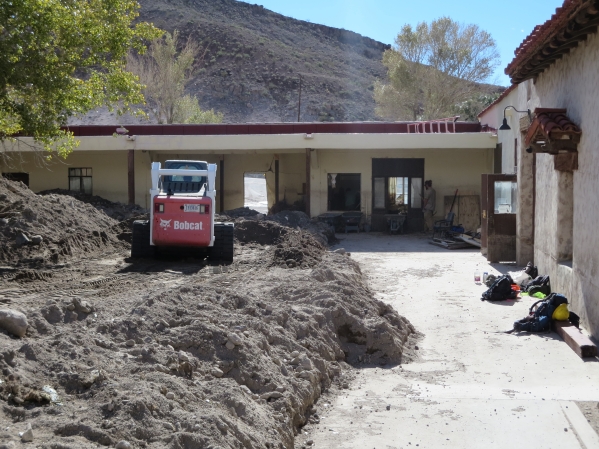
After torrential downpours flooded out sections of Death Valley National Park, the area continues to clean up and recover.
Scotty’s Castle received 2.7 inches of rain on Oct. 18, with an area just a half-mile away receiving 3.5 inches of rain, and saw some of the worst of the damages in the entire park.
Mud and debris were removed from around several buildings last week as up to four feet of mud was left behind in areas of Scotty’s Castle.
Since Saturday crews have progressed along Harry Wade Road, clearing approximately eight miles of road since Scotty’s Castle area.
Crews continue to remove debris from the around the Cookhouse and mud and silt from the tunnels.
Cleaning and repair work is taking place on the culverts, and removal of downed cottonwood trees continues. In addition, the trail to Scotty’s grave has been repaired.
To give a larger sense of the magnitude of work the crews at the national park are conducting the park service compared the debris weight to a beloved American site.
“Crews are removing an estimated 400,000 tons of debris from park roads, which the the equivalent of the weight of five Washington Monuments.”
Historic objects that were put away were unpacked and there was an assessment of the area by archeologists.
The main building sustained only minor damage due to roof leaks, but the HVAC system is not operational due to compromised utilities. In addition, historic furniture, archives and other museum collections are threatened by mold, rodents, dust and the lack of a fire suppression system.
It is estimated that ranger tours through Scotty’s Castle generate around $550,000 in fees annually, with about 120,000 people per year visiting the site. Scotty’s Castle will not reopen anytime soon as the area is likely to be closed for the foreseeable future.
Around five miles of road near Scotty’s Castle was destroyed in the flood and is currently closed to visitors. A one-lane dirt road has been created in order for work crews to travel in and out of the area safely.
Near Badwater, Badwater Road remains closed due to several areas of the road being washed out along a 10-mile stretch.
Artists Drive, a paved road and Twenty Mule Team Canyon Road, a dirt road, remain closed due to missing sections of Artists Drive and the dirt road being washed out during the storm.
In the historic district, a bridge was moved slightly but is still usable. The historic long shed and bunkhouse are surrounded by up to five feet of mud. The historic pool was also hit as it is filled with water and mud.
Utilities were also hit, as a water treatment facility was damaged; 24 power poles were decimated and the propane line was broken in the historic district.
Damage assessments in Death Valley are ongoing, but current estimates have the damage coming in at tens of millions of dollars.
With an overly-active El Nino season predicted, more rain events could be headed Death Valley’s way this winter.
The effects are a double-edged sword, as more floods would certainly hamper any work being done at the time to repair areas affected by the storm, but a spring wildflower event could happen as result of the above-average precipitation, which could draw increased park visitation during the park’s centennial anniversary year celebration.
If you plan to travel to Death Valley National Park check ahead to see if the destination you want to see is open and accessible. You can get park updates by visiting www.nps.gov/deva or checking their Facebook page at www.facebook.com/DeathValleyNP.
Contact reporter Mick Akers at makers@pvtimes.com. Find him on Twitter: @mickakers.